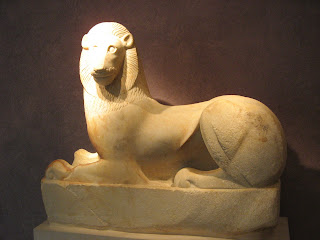A major permanent exhibit in the museum is the remnants of a 7th century church which had to be moved from its original location in northern Greece because it would be under water when a dam was constructed. Just below is the iconostasis wall and beneath it are the remainders of the walls which were saved.



13th century mosaic depiction of the Virgin
marble sarcophagus from 11th century Athens.

Below: martyrs' table from 4th century AD Greece; pilgrims/worshippers would leave money in the recessed areas of the table below the names of particular martyrs.

Funerary stele of two figures from 3d or 4th century B.C. from Egypt.

Museum administrative building is in a
 former villa in the Italian style which was donated to the museum.
former villa in the Italian style which was donated to the museum.Up the block from the Byzantine Museum is Greece's War Museum. Unlike the National Historic Museum (see Friday's entry), this well-organized collection DOES recognize that World War II did exist. Unfortunately, only a small percentage of its signage was in English; however, the story of the Greek partisans came across very clearly. There was also some emphasis on the Greek War of Independence in 1829 with Turkey.

I'm a sucker for military flags and insignias; these are of the various Greek regiments currently in the Army. By the way, miltary service is compulsory for all Greek men with very little compensation; however, Greek women who volunteer for the military are paid relatively handsomely.
A modern sculpture outside the War Museum.


A WWI mobile gun carriage captured from the Bulgarians, who fought on the side of the Germans and were particularly active in Greece and other Balkan countries.
Entrance to the War Museum
The next destination after the War Museum was the Kerameikos, which had been a cemetery for Athen's elite and also the site of the main ceremonial entrance to the ancient central city. It was located at the opposite end of the center city from the War Museum, so I took the subway for the only time while there. The subway system was greatly enlarged for the 2004 Summer Olympic games, but its construction was/is an excrutiating experience. Practically each shovelful (and we're apparently talking the kind of shovels in the hands of individual laborers) of excavation has to be inspected by government officials looking for archeological sites. Both of the subway stations I was in had displays of what was found when those stations were being built. A portion of the main subway line from the city center out to the airport (a distance of about fifteen miles) is closed for simulataneous construction of three new stations and that process is estimated to take three years.
Sorry for that digression. So, we're headed to the Kerameikos, which is easily found outside the subway station. But, NOT the station with the same name. So, I walked around the Kerameikos until finally finding the doorway into the cemetery.
Replica of a headstone named "Two Sisters" who stare vacantly into the distance. The original stone is inside the cemetery museum. Vistors coming into the city would walk down the street that had memorials such as these all along the way.
The Kerameikos was once outside the city's walls, but as the city grew, a series of replacement and concentric walls were built. The final ring of walls included the cemetery inside the city for the first time and the main ceremonial entrance arch was built at the cemetery. Once inside, there were two paths, both illustrated below. The path on the left--the "Sacred Way"--was the ceremonial one which was broader and more formal, leading to a temple. The path bending to the right went past a valley of large burial monuments and was intended more for commerce and ordinary people; even then the marketing concept of "location, location, location" was employed since the path went through a neighborhood of brothels.
A sacred gate lion from around 590B.C., now located in the Kerameikos Museum.

I was, of course, on the "Sacred Path." By the way, the Obama shirt initiated a number of conversations with visitors/natives alike and all were positive.

The final stop of the day was Mitropoli, the Greek Orthodox equivalent of St. Peter's in Rome. It was built in 1862, the first major church after Greece's independence, and was currently undergoing rehabilitation on the outside.
Unfortunately, its main entrance and one entire side was covered by scaffolding, but the inscription on the back of the statue was of some interest. The archbishop commemorated here stood up to the Nazi commandant of the Athens area during WWII who wanted to hang several priests for working with the partisans. He insisted that the priests die with some "honor," such as being shot. The Germans accommodated.
The silver reliquary contains the bones of St. Agia Filothei (d. 1589) who was martyred for ransoming Greek women enslaved in Turkish harems.
Below: One of several silver-covered icons in the vestibule area of the cathedral, whose proper name is Annunciation of the Virgin.








No comments:
Post a Comment